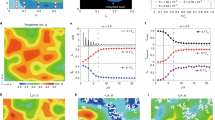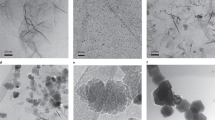Abstract
The formation of small crystallites is governed by two competing factors: the free energy gained upon transferring constituent atoms, molecules or colloidal particles from the metastable liquid to the more stable solid, and the free energy needed to create the surface area of the crystallite1. Because the ratio of surface area to bulk is large for small particles, small crystallites dissolve spontaneously under conditions where larger crystallites are stable and macroscopic crystal growth occurs only if spontaneously formed crystallites exceed a critical minimum size. On theoretical grounds1, the probability of forming such critical crystal nuclei is expected to increase rapidly with supersaturation. However, experiments show1,2 that the rate of crystal nucleation in many systems goes through a maximum as the supersaturation is increased. It is commonly assumed that the nucleation rate peaks because, even though the probability of forming critical nuclei increases with increasing concentration, the rate of growth of such nuclei decreases. Here we report simulations of crystal nucleation in suspensions of colloidal spheres with varying size distributions that show that the probability that critical nuclei will form itself goes through a maximum as the supersaturation is increased. We find that this effect, which is strongest for systems with the broadest particle size distribution, results from an increase with supersaturation of the solid–liquid interfacial free energy. The magnitude of this effect suggests that vitrification at high supersaturations should yield colloidal glasses that are truly amorphous, rather than nano-crystalline.
This is a preview of subscription content, access via your institution
Access options
Subscribe to this journal
Receive 51 print issues and online access
$199.00 per year
only $3.90 per issue
Buy this article
- Purchase on Springer Link
- Instant access to full article PDF
Prices may be subject to local taxes which are calculated during checkout


Similar content being viewed by others
References
Kelton, K. F. Solid State Physics Vol. 45 (eds Ehrenreich, H. & Turnbull, D.) 75–178 (Academic, New York, 1991).
Pusey, P. in Liquids, Freezing and Glass Transition (eds Hansen, J. P., Levesque, D. & Zinn-Justin, J.) 763–931 (North-Holland, Amsterdam, 1991).
Kofke, D. A. & Bolhuis, P. G. Freezing of polydisperse hard spheres. Phys. Rev. E 59, 618–622 (1999).
Palberg, T. Crystallization kinetics of repulsive colloidal spheres. J. Phys. Condens. Matter 11, 323–360 (1999).
Van Duijneveldt, J. S. & Lekkerkerker, H. N. W. in Science and Technology of Crystal Growth (eds van der Eerden, J. P. & Bruinsma, O. S. L.) 279–290 (Kluwer Academic, Dordrecht, 1995).
Harland, J. L. & Van Megen, W. Crystallization kinetics of suspensions of hard colloidal spheres. Phys. Rev. E 55, 3054–3067 (1997).
Zhu, J. et al. Crystallization of hard-sphere colloids under microgravity. Nature 387, 883–885 (1997).
Auer, S. & Frenkel, D. Prediction of absolute crystal-nucleation rate in hard-sphere colloids. Nature 409, 1020–1023 (2001).
Oxtoby, D. W. & Kashchiev, D. A general relation between the nucleation work and the size of the nucleus in multicomponent nucleation. J. Chem. Phys. 100, 7665–7671 (1994).
Shi, F. G., Tong, H. Y. & Ayers, J. D. Free energy barrier to nucleation of amorphous-to-crystalline transformation selects the scale of microsctructure of crystallized materials. Appl. Phys. Lett. 67(3), 350–352 (1995).
Ten Wolde, P. R. & Frenkel, D. Enhancement of protein crystal nucleation by critical density fluctuations. Science 277, 1975–1978 (1997).
Gasser, U., Weeks, E. R., Schofield, A., Pusey, P. N. & Weitz, D. A. Real-space imaging of nucleation and growth in colloidal crystallization. Science 292, 258–262 (2001).
Pusey, P. N. & Van Megen, W. Phase behaviour of concentrated suspensions of nearly hard colloidal spheres. Nature 320, 340–342 (1986).
Ten Wolde, P. R., Ruiz-Montero, M. J. & Frenkel, D. Numerical evidence for bcc ordering at the surface of a critical fcc nucleus. Phys. Rev. Lett. 75, 2714–2717 (1995).
Acknowledgements
We thank A. van Blaaderen, P. M. Chaikin, H. N. W. Lekkerkerker, D. Oxtoby, W. B. Russel and F. Shi for comments and suggestions. This work was supported by the division of Chemical Sciences of the Netherlands Organization for Scientific Research (NWO). The work of the FOM Institute is part of the research programme of FOM and is made possible by financial support from the NWO. Access to the TERAS supercomputer was made possible through a grant by the NCF.
Author information
Authors and Affiliations
Corresponding author
Rights and permissions
About this article
Cite this article
Auer, S., Frenkel, D. Suppression of crystal nucleation in polydisperse colloids due to increase of the surface free energy. Nature 413, 711–713 (2001). https://doi.org/10.1038/35099513
Received:
Accepted:
Issue Date:
DOI: https://doi.org/10.1038/35099513
This article is cited by
-
Emerging exotic compositional order on approaching low-temperature equilibrium glasses
Nature Communications (2023)
-
Bifunctional interface modification for efficient and UV-robust α-Fe2O3-based planar organic–inorganic hybrid perovskite solar cells
Advanced Composites and Hybrid Materials (2022)
-
Energy polydisperse 2d Lennard–Jones fluid in the presence of flow field
Pramana (2022)
-
A conceptual change in crystallisation mechanisms of oxide materials from solutions in closed systems
Scientific Reports (2020)
-
Instantaneous dimensionless numbers for transient nonlinear rheology
Rheologica Acta (2019)
Comments
By submitting a comment you agree to abide by our Terms and Community Guidelines. If you find something abusive or that does not comply with our terms or guidelines please flag it as inappropriate.



